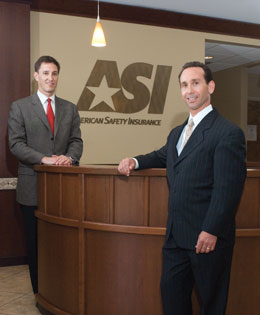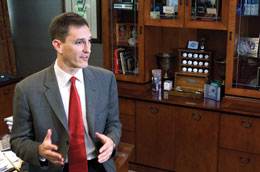|
Specialty savvy
American Safety thrives on tough risks
By Phil Zinkewicz
To standard property and casualty insurers, competition in the marketplace is either a blessing or a curse, depending on the impact it is having on the industry at any given time. “Healthy” competition can inspire insurers to design innovative products and allow them to enjoy an edge over those who are less adaptable to change. It also provides more choices for consumers and promises that rates for insurance products will not spiral out of control. However, “excessive” competition in the marketplace can result in insurers’ underpricing their products to such a degree that bottom-line results may suffer, especially in some of the more volatile, long-tail exposures.
Until the 1970s, insurance cyclicality was fairly predictable. Usually, cycles were three-years-on and three-years-off periods of soft and hard markets. They were predictable because competition in the industry consisted of traditional insurers going head to head against other traditional insurers. Competition therefore was contained within a relatively small group.
Then, in the late 1970s, new players began competing in the property and casualty arena. Those new players were the insureds themselves. Frustrated by a hard market where coverages became restricted and prices were perceived as extremely high, those insureds began setting up their own insurance companies, called captives, and the alternative risk transfer (ART) market was born. In effect, insurers, by their own actions, created new competition, and that was the beginning of the end of traditional insurance market cyclicality.
In the early days, the alternative insurance market grew slowly. A soft standard market in the early 1980s, with coverages more available and prices sweet and low, made captive formation seem unnecessary. But when the market hardened with a vengeance in the mid-1980s and federal risk retention legislation was passed, the alternative market took on new life and traditional insurers found that they were competing over the long term with a whole new group of industry participants.
One such participant was American Safety Insurance Holdings, Ltd. The company was formed in Bermuda during the hard market of 1986 when those involved in the asbestos abatement and environmental industry in the United States found that coverages were either unavailable in the traditional insurance market or were extremely costly. “Without legitimate insurance coverage, property owners, contractors and consultants could not perform much-needed work to protect their properties, the environment and the public,” says Stephen Crim, president and chief executive officer of American Safety Insurance Holdings, Ltd. “American Safety Insurance was formed as a group captive to provide stable, long-term insurance protection for environmental exposures.”
Expanding the focus
Over the last 20 years, American Safety Insurance has grown from a captive focused on one market into a multiline specialty insurance group, says Crim. “ASI operates in the specialty risk and alternative insurance market,” he says. “We develop customized insurance products and provide a broad range of insurance, reinsurance and risk management solutions to fit the needs of specialty niche industries and risks. We were formed to provide insurance solutions for an underserved marketplace, and our growth has come from our ability to identify other markets whose insurance needs have not been met by the traditional insurance arena.”
According to Crim, ASI’s growth over the years can be attributed to developing expertise in identifying insurance and risk management opportunities not addressed in the standard insurance market. “Typically, ASI targets niche insurance markets that are underserved because they: (1) are small in size or in the amount of coverage needed; (2) have unique characteristics or need unusual coverages; or (3) have not yet been identified by competitors. For these markets, ASI is able to offer a broad array of innovative insurance and risk management solutions.”
Today ASI has in its stable American Safety Casualty Insurance Company, American Safety Indemnity Company, American Safety Reinsurance, Ltd., and American Safety Risk Retention Group, Inc., which share a group Best’s rating of A VIII. These companies provide insurance products not only for environmental risks, but also for construction, products liability, manufacturing and other specialty exposures. In addition, ASI writes contract surety bonds for small to medium-sized environmental exposures and also offers excess and umbrella liability. ASI has two core segments—an excess and surplus segment, which includes construction, environmental liability, surety and specialty casualty units—and the alternative risk transfer segment, which includes its specialty program and fully funded units.
Full funding option
As a part of its alternative risk transfer segment, ASI develops fully funded policies for insureds that want to have more control over both the cost of their insurance program and the claims handling process. Joseph D. Scollo, Jr., executive vice president and chief operating officer, describes the program as one with a fully funded policy for general and/or professional liability coverages where the insured collateralizes the policy aggregate limit. One of the ASI companies serves as the policy issuing carrier so that the insured can meet insurance requirements. The insured then fully funds the policy aggregate limit in the form of cash or irrevocable letter of credit. ASI can facilitate the risk assumption by the insured through its Bermuda segregated account company, American Safety Assurance, Ltd.
During the most recent hard market, this product served to fill a void in the nursing home and residential construction industries. “We developed this program because we were receiving requests from our brokers to provide a self-funded vehicle for risks in these industries,” says Scollo. “Liability coverage was either unavailable, the prices too high or the claims handling process of insurers inadequate. The idea was to provide an opportunity for these risks to self-insure and still meet the contractual and regulatory insurance requirements of these insureds. The demand for this product is also driven by the desire to have more control over the cost of insurance and claims handling than is currently afforded by traditional markets. The fully funded product is also available to other classes of risk that find themselves in a similar circumstance. Nursing homes and residential contractors have been the largest market for the product thus far, but it is easily adaptable to other underserved markets.”
Ten years ago, ASI decided to use its expertise in dealing with underserved markets by getting into the program arena. ASI entered the program market in the late 1990s, according to Scollo, with one of its first ventures being a pest control program for a small insurer in Louisiana that was looking to expand into other states. “We have since expanded our specialty program writings, finishing 2005 at $85 million in gross written premiums,” Scollo says. “We look for programs that generate between $5 million and $20 million annually in written premiums, where the program manager has an established track record of underwriting a specialty book of business and is willing to share in the underwriting profits or losses of the business underwritten. We’ve had our greatest success by developing new programs in the smaller, $5 million to $10 million range.”
Adaptability is key
Crim says a key reason for the success of the ART market is its adaptability. “For example, in the 1970s,” he says, “traditional insurance companies were writing risks with environmental exposures on ISO forms, under the impression that pollution was excluded. When they found out they were on the hook for pollution exposures, their reaction was to get out of the market. We developed a form to provide liability coverage that allowed us to offer a solution that mitigated our risk. The same is true in the construction industry. The Montrose decision in the mid-1990s had a negative effect on construction defect claims, so traditional insurers pulled out of the market. We crafted a policy form that provided insurance to contractors and also gave us protection against those types of claims.”
Crim says that the concept of ART has generally been tied to traditional market cyclicality. The ART market tended to grow during hard market periods and then stabilize during soft markets. “Although growth slowed down during soft markets, the vehicles that were set up stayed,” says Crim. “You don’t typically go to the trouble and expense to set up a captive or a risk retention group just to disband it when the market softens. But today, even though the market is softening in some lines, the importance of the ART market cannot be denied, especially in certain areas such as medical malpractice, construction and the environment.”
So the ART market is here to stay, according to Crim. “Alternative risk vehicles were created in response to a traditional market that was unresponsive to certain exposures. As long as that continues to happen, there will always be a place for sound alternatives to traditional insurance.” *
For more information:
American Safety Insurance Holdings, Ltd.
1845 The Exchange
Atlanta, GA 30339
Phone: (800) 388-3647
E-mail: Info@americansafetyinsurance.com
Web site: www.americansafetyinsurance.com |
|
Click on image for enlargement |
 |
| |
Stephen R. Crim (left) is President/CEO of American Safety Insurance Holdings, Ltd., and Joseph D. Scollo, Jr., is Executive Vice President/COO. |
| |
“Our growth has come from our ability to identify markets whose needs have not been met by the traditional insurance arena.”
—Stephen R. Crim |
| |
 |
|


